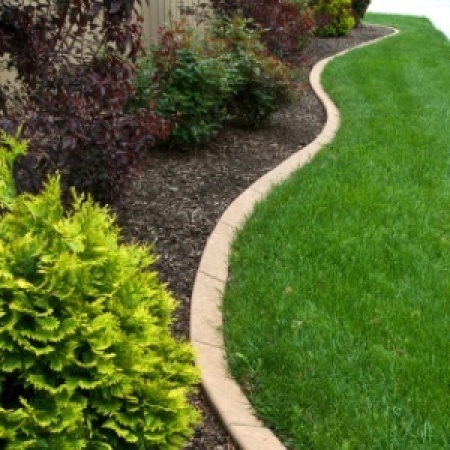
Landscape edging is a great way to create clean, well-defined borders between garden spaces, and give your garden a finished appearance. It's also functional-keeping grass out of your plants, while keeping soil, rocks, and mulch from spilling into your lawn.
When it comes to selecting edging materials, there are several things to consider: the overall look you are trying to achieve, material costs, installation time, and maintenance issues, such as mowing.
With its timeless natural beauty, concrete, stone, or brick edging can make a strong visual impact around garden beds. The upfront costs are higher, but the strength and durability of these materials will last a lifetime. There are also unlimited sizes, colors, and styles to choose from, making it easy to find materials that will compliment your homes exterior. Materials are not dug as deeply into the ground as other types of edging, so if not tightly interlocked or mortared together, grass and weeds may eventually sneak through the cracks and take up residence into your garden beds.
Durability: Lasts a lifetime.
Considerations: Reusable molds are available that allow do-it-yourselfers to create customized edgings in a variety of patterns and colors using fast drying cement. If you have a large area to cover, you may want to purchase 2-4 molds to speed up production.
Metal edging is usually made from steel or aluminum. Because of its durability and flexibility, many professional landscapers use metal for both commercial and residential edging projects. Steel edging it more rigid and is well suited to separating hardscapes like driveways and patios. Aluminum is softer and more flexible and works well for edging lawns and garden beds. Both come in several colors and are available in 8, 10, or 16-foot sections that can be joined together with special clips.
Durability: Aluminum and galvanized steel will last nearly forever.
Considerations: Steel edging may be affected by frost heaves and unless galvanized, is susceptible to rust. Aluminum edging does not rust.
Like metal, some plastic edgings contain enough flexibility to accommodate irregular or curved shapes. Although not necessary as aesthetically appealing as other materials, plastic edgings are economical, readily available, and relatively easy to work with. Depending on the type, plastic edging comes in large rolls, rigid panels, or in pre-cast molds designed to look like wood or natural stone.
Durability: Very durable-varies some according to type. Some plastics may become brittle after long-term exposure to sun and extreme temperatures.
Considerations: Sharp, crisp corners are difficult to obtain using plastic edging, and certain types need to be securely anchored with stakes to keep them from popping out of the ground. When possible, consider using recycled plastic products. They never biodegrade and can be recycled again if you ever decide you no longer want them.
Because of its natural, rustic appearance and affordability, wood is a popular edging material. It works will for defining straight borders, but does not work well for defining curves. Eventually, all types of wood will deteriorate and have to be replaced. Untreated wood is safe for the environment and actually enhances the soil as it decays.
Durability: Durable-depending on the wood. Redwood, cedar, and cypress are naturally rot resistant, but are more expensive than other type of wood. Damage caused by insects can be problematic in certain areas.
Considerations: Avoid pressure treated wood or wood that is covered in creosote (railroad ties). Over time, they can leach chemicals into the soil that can harm both plants and beneficial insects.
Living plants such as dwarf shrubs, and low-growing annuals and perennials make attractive edgings. Use shrubs like boxwood and barberry; perennials like alpine strawberries, lavender, or dwarf day lilies; annuals like alyssum, lobelia, or verbena. The possibilities and color combinations are endless.
Durability: Varies depending on the life of the plants.
Considerations: Plants are a great way to soften hard edges. Although beautiful, "living" edgings are not effective in preventing grass from infiltrating into garden beds and they require constant care and maintenance.
Measuring: Once you decide where to install your edging, use a garden hose or string to mark off the area, then measure how many feet of edging you will need to buy.
Digging: To keep grass and plant roots contained to their respective sides of your edging, always dig a trench that is at least 4 to 6 inches deep and slightly wider than your edging requires. For shrubs and hedges with deeper roots, dig down ever deeper-2 feet or more.
Installation: Install your edging when the soil is dry. Heavy rain can cause the ground to swell and cause edging to shift once it dries. Sink flush edging into the ground vertically until it sits a half-inch (or less) above the ground. Using a rubber hammer, drive stakes into the ground every few feet to secure the edging in place. To level concrete and brick edging, spread a thin layer of sand into the trench to create an even surface. Stone edging can be dug into the ground at the desired height.
Fill any gaps: Once your edging is in, use soil to backfill any gaps or holes along the edges.

About The Author: Ellen Brown is an environmental writer and photographer and the owner of Sustainable Media, an environmental media company that specializes in helping businesses and organizations promote eco-friendly products and services. Contact her on the web at http://www.sustainable-media.com
Add your voice! Click below to comment. ThriftyFun is powered by your wisdom!
Great advice. We're leaning toward metal edging, or bricks.
I got all of my edging and my white rocks free from craigs list! even got some free for my neighbors as well! and created gardens for them! I got cement edging, "blocks" and both river rocks and some bigger rocks;
and some great hard plastic blocks 3 different sizes I passed on to a church putting in their gardens!
All free from craigs list folks! www.craigslist.org
Add your voice! Click below to comment. ThriftyFun is powered by your wisdom!